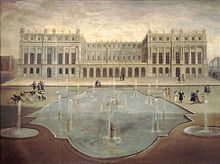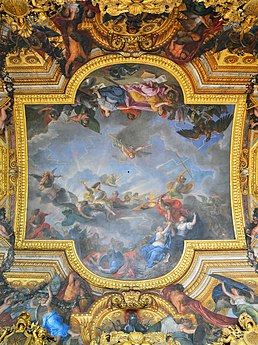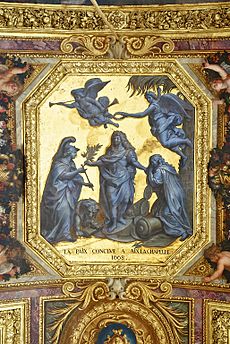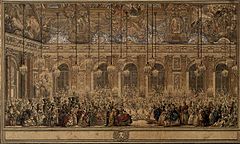Hall of Mirrors at Versailles
The 300-year-old Hall of Mirrors of Versailles (or the Mirror Gallery , Galerie des Glaces , Galerie de Louis XIV. Or la Grande Galerie ) is one of the largest and at the same time the most famous room in the Palace of Versailles near Paris in France . The baroque hall with the neighboring salons of war and peace forms the center of the palace's parade rooms and has been the focus of European history several times.
Art historical overview
Building history
The Palace of Versailles was built in 1623 under King Louis XIII. built as a small hunting seat. His son Louis XIV stayed there regularly from 1661 and had the hunting lodge expanded into an extensive residence over several years. In an early expansion phase under the direction of Louis Le Vau , the old castle was encased in the north and south by two new wings . These two wings towered over the original building to the west in the direction of the garden and the area between them was taken up by a terrace supported by arcades . The buildings of the enclosure contained the king's apartments in the north and those of the queen in the south.
From 1678, under the direction of Jules Hardouin-Mansart, another, larger expansion phase began. The central terrace was built over and the mirror gallery was created in its place by 1684. The garden facade of the Corps de Logis was thus closed in one escape and was largely given its current appearance. At the ends of the Hall of Mirrors is the Salon of War to the north and the Salon of Peace to the south . The mirror gallery connects the two rooms, which were assigned to the king's apartment in the north and the queen's apartment in the south. Both rooms can be reached from the gallery through open passageways, the three halls form a unit through their equipment and decoration. The rooms of the salons date back to the time the castle was wrapped by Le Vau, they got their current appearance after the renovation and installation of the Hall of Mirrors by Hardouin-Mansart.
In addition to the palace chapel , which was completed at the beginning of the 18th century , the court opera and the battle hall set up in the 19th century , the mirror gallery is one of the largest rooms in the palace. It is 73 meters long and 10.50 meters deep. With its height of 12.3 meters, it extends up to the attic floor of the Corps de Logis, the square windows on the upper floor that can be seen from the outside serve only for aesthetic purposes, there are no rooms behind at this point. Due to its size, the hall of mirrors could not be heated, so the installation of chimneys was avoided from the outset.
Artistic equipment
The hall of mirrors, one of the highlights of the Louis-quatorze , opens with 17 windows in the direction of the park, opposite these are 17 equally large mirrors with more than 350 individual mirror surfaces on the inner wall of the hall . On the one hand, the mirrors had an aesthetic function, because they expand the outside area of the palace into the interior of the building by mirroring the garden and also reflect the candlelight in the evening. On the other hand, they also conveyed in a subtle way the wealth of the king and the efficiency of the French economy. In the 17th century, mirror glass was an expensive luxury product and could only be manufactured with great effort. The production of the mirror surfaces was the first major order for one of Jean-Baptiste Colbert founded glass manufactory , which later became Saint-Gobain , which the Venetian monopoly was broken in the area.
The impression of the hall is not only shaped by the mirrors, but also by the huge vault. The nine large and numerous smaller ceiling paintings are all about the glorification of the Sun King and praise the successes of his first 20 years of reign. In addition to the painting The King himself rules , which illustrates the ruler's claim to absolute power, the peace of Nijmegen and the conquest of Franche-Comté are also discussed. The artist was Charles Lebrun . According to a contemporary anecdote, the furnishing of the Great Gallery with the seventeen mirror surfaces goes back to an idea by Jules Hardouin-Masart, who wanted to prevent Lebrun, who was highly favored by the king, from having more opportunities to close his works present.

For the mirror gallery, valuable fittings, some of which were solid silver furniture, were originally made. The furniture, which was famous at the time, only had a short life; it had to be sold and melted down as early as 1689 to finance the Palatinate War of Succession . Today's furniture dates largely from the 19th century, after much of the castle's original furnishings were lost during the French Revolution .
Like the entire Palace of Versailles, the mirror gallery was a role model and was imitated in various shapes and dimensions in numerous European courts of the 17th and 18th centuries. The best-known imitation, however, is a work of the 19th century, it is the large hall of mirrors in Herrenchiemsee Palace on Herreninsel in southern Bavaria . Under King Ludwig II , the central building of the Versailles Palace was almost rebuilt there from 1878 and the Hall of Mirrors was also copied down to the last detail and with only a few deviations.
- from: Details of the decoration of the mirror gallery of Versailles
Louis XIV as a victorious general , ceiling painting by Charles Lebrun in the mirror gallery of Versailles
restoration
The hall of mirrors was extensively restored from 2003 to 2007 in several stages for 12 million euros. The paintings were cleaned, the stucco was added and worked out, and blind mirror panes were replaced. The work was carried out using mobile scaffolding while the museum was still open, so that the main attraction of the palace did not have to be closed. The seven heavy chandeliers have also been restored and fitted with modern pipes.
Historical overview
Use of the hall of mirrors
The mirror gallery had various functions to fulfill. Due to its size and rich furnishings, it is mostly mistaken for a ballroom, but its main purpose was to serve as a kind of covered promenade. A large part of daily court life took place here and the company met to promenade, exchange news or please the king. The gallery was big enough that the ruler could go around unpleasant people on his walks through the hall or turn to people of his interest. Anyone who had a concern stayed in the Hall of Mirrors, where it was hoped to be noticed by the king. He entered the gallery least once a day: The king's bedroom was in 1701 behind the center wall of the gallery and in an unchanging ritual, the monarch after the morning rising, which went Lever , from the bedroom through the Hall of Mirrors and the subsequent parade spaces for chapel in the north wing .
Its central location and size predestined the mirror gallery as a place for court festivals. Among other things, the wedding of the Duke of Burgundy to Maria Adelaide of Savoy in 1697, the wedding of Louis Ferdinand and Maria Theresa of Spain in 1745 and the wedding of Louis XVI in 1770 were carried out here at great expense . and Marie Antoinettes celebrated. The hall of mirrors also served as a throne room for large receptions, for example the ambassadors of Siam in 1686 , the ambassadors of Persia in 1715 and the ambassadors of the Ottoman Empire in 1742 .
Historical events
The Spiegelgalerie went down in history through two historical events : In the Franco-Prussian War of 1870/1871, the Prussian leadership chose it as the location for the imperial proclamation of January 18, 1871 , which was to be considered the founding act of the German Empire . The choice fell on the Hall of Mirrors because its ceiling paintings glorified, among other things, the conquests of German countries by France. The French people felt the ceremony as a humiliation, which should cement the Franco-German enmity for decades.
The signing of the Versailles Peace Treaty , the most important of the Paris suburb treaties , took place in the Hall of Mirrors on June 28, 1919 at the request of French Prime Minister Georges Clemenceau .

This time it was the German people who felt the ceremony as humiliation. This and the heavy conditions of the peace treaty, to which Germany was solely responsible for the war, continued to strain relations between Germany and France. The Treaty of Versailles is held responsible as one of the reasons for the rise of the National Socialists in Germany and thus as a cause of the Second World War . Franco-German relations only began to improve after the end of the war .
literature
- Jean-Marie Pérouse de Montclos, Robert Polidori : Versailles. Könemann, Cologne 1996, ISBN 3-89508-424-7 .
- Nicholas d'Archimbaud: Versailles. Stiebner, Munich 2001, ISBN 3-8307-0172-1 .
Web links
Individual evidence
- ↑ a b chateauversailles.fr (PDF; 80 kB), accessed on August 2, 2011.
Coordinates: 48 ° 48 ′ 17.5 ″ N , 2 ° 7 ′ 13.1 ″ E












